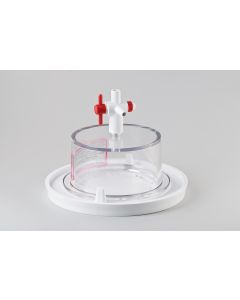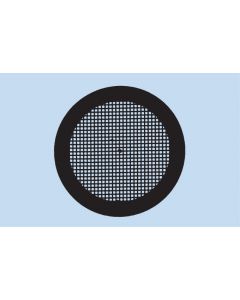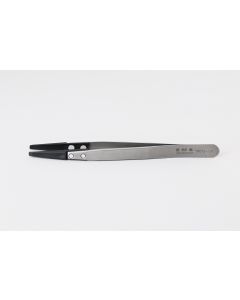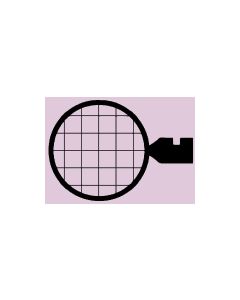Diethylene Glycol Distearate (DEGDS/DGD)
DGD ist ein entfernbares Einbettmedium (für Semi- und Ultradünne Schnitte). Es lassen sich Schnitte herstellen, die frei von Einbettmedium sind und für Immunmarkierung und hochauflösende Lichtmikroskopie geeignet sind.
Produktdetails
Beschreibung
DGD provides embedment free sections. It is a removable embedding resin for thin as well as thick sections.
Procedures(Capco and McGaughey, 1986)
- Tissue are fixed with glutaraldehyde and osmium tetroxide, and then dehydration should follow in a graded ethanol series in accordance to standard procedures including at least two hour incu-bation with several changes of 100% ethanol.
- Tissue is then gradually transferred to graded n-butyl alcohol (at least a 1:1 mixture of n-butyl alcohol and 100% ethanol)
- Follow with several changes of 100% n-butyl alcohol over 2-3 hours. During the final changes of n-butyl alcohol samples need to be in a 70°C oven for about 15 minutes prior to infiltration with the embedding medium.
Diethylene Glycol Distearate is a white waxy solid at room temperature. Therefore, Fully melt DGD at 70°C prior to use. Filter it through Whatman #1 filter paper in order to remove particulate that may appear in molten DGD. This step should take place in a warm environment or directly in an oven. - The addition of 0.3 - 0.5% (v/v) dimethyl sulfoxide (DMSO) to DGD will reduce the shrinkage of the final block.
- The specimens are transferred from 100% n-butyl alcohol to a mixture of 1:1 of n-butyl alcohol and molten DGD and are incubated for at least 45 minutes.
- They are then passed through a minimum of two more changes of molten DGD (with DMSO) and are incubated for two to three hours each change, depending on the size of the specimens.
Solidified DGD is very brittle; hence it is difficult to obtain blocks from capsules without breaking the block. Therefore, for embedding, a silicone flat embedding mold with 3mm or 4mm deep cavities ( EMS #70902 or #70900) is recommended. - To help maintain DGD in a liquid state during specimen orientation in the embedding mold, place the mold on a hot plate (set @ 65 to 70°C) or next to a heat lamp.
- Transferred the specimen to the tip of each cavity and fill the cavities with molten DGD (with DMSO).
- Remove the mold to room temperature and allow it to harden. During the hardening process, add two drops of molten DGD to each cavity at the opposite side of where the specimen is. This will produce a flat upper surface on the block.
- Remove the blocks from the mold with extreme care by first loosening the surrounding edges between the block and the cavity of the mold. Gently bent the mold and lift the block out.
DO NOT STRESS THE BLOCK IN ANY WAY. These blocks can be placed in a vise type chuck for trimming and sectioning. Do not trim with deep cuts for this may cause the block to fracture . The block is hardness is dependent on the room temperature and is should be no greater than 75°C . Do not touch the block with your fingers, for this can cause the block to soften. - The section is collected on formvar/carbon coated grids pretreated with 0.1% polylysine (just prior to use). Section has a tendency to float off the grids during the removal of the embedding media from the section. To prevent this from occurring it is suggested that after the initial collec-tion of the sections onto the grids, they be dried and an additional drop of polylysine be applied to each grid and allowed to incubate for a few minutes. Remove the excess and store in a desiccator‘s overnight. This will improve the adhesion of the section to the grid.
- The grids are completely dried and the DGD is removed from the sections by immersing the grids very carefully in 100% n-butyl alcohol for one hour.
- Transfer the grids to a 1:1 mixture of 100% n-butyl alcohol and 100% ethanol for 15 minutes; finally transfer the grids to 100% ethanol for an additional hour, swirled gently, and then allowed to sit for another 15 minutes. The grids are now ready for critical point drying.
Tips
Grids should be store in desiccators until use. It is suggested that the emission current of the TEM be reduced to one half what would be typically used for resin embedded sections. As well the cold trap should be completely filled.
If the specimen is not stable, a thin layer of carbon can be evaporated onto the surface of the speci-men prior to observation.
Embedment free sections have high contrast; hence developing conditions need to be adjusted. Use Kodak film 4489 developed in a fresh solution of D-19 diluted to 1:8 with water and developed for eight minutes.
STAINING IS NOT REQUIRED.
References
1. Capco, D.G., Krochmalnic, G. and Penman, S. (1984). A new method of preparing embedment-free sections for TEM: application to the cytoskeletal framework and other three-dimensional networks. J. Cell Biol., 98:1878.
2. Capco, D.G. and McGaughey, R.W. (1986). Cytoskeletal reorganization during early mammalian development analysis using embedment-free sections. Develop. Biol., 115:446.
3. Porter, K.R. and Anderson , K.L. (1982). The structure of the cytoplasmic matrix preserved by freeze-drying and freeze-substitution. Eur. J. Cell Biol., 29:83.
4. Lachapelle, M. and Lafontaine, J.G. (1987). Observation on the ultrastructural preservation of the nucleus in the myxomycete polycephalum as observed in resinless sections. J. Elec. Micros. Tech., 5:227.
5. Weed, H.G., Krochmalnic, G., and Penman, S. (1985). Polivirus metabolism and the cytoskeletal framework: detergent extraction and resinless section microscopy. J. Virol.,56:459.
6. Hayat, M.A. (1989). Principle and Techniques of Electron Microscopy: Biological Applications. Third Edition. CRC Press, Inc.
Weitere Informationen
| Anwendung |
TEM
|
|---|---|
| Gebotszeichen |
Augenschutz benutzen

Handschutz benutzen

|
| Signalwort |
Gefahr
|
| Symbol GHS |
GHS02

GHS05

GHS07

|
| Gefahrenhinweise |
H225
H226
H302
H315
H318
H319
H335
H336
H350
|
| Sicherheitshinweise |
P210
P241
P280
P310
P321
P330
P362
P303_361_353
P305_351_338
P405
P501
|
| Bestandteile | 450ml DGD, 450ml Ethanol, 450ml n-Butyl Alkohol, DGD Einbettkit |
| Versandklasse |
Gefahrgut LQ
|
| Lagertemperatur |
RT
|
| SDB (mehrsprachig) | E13255 |
| SDB (mehrsprachig) | E15055 |
| SDB (mehrsprachig) | E11920 |














